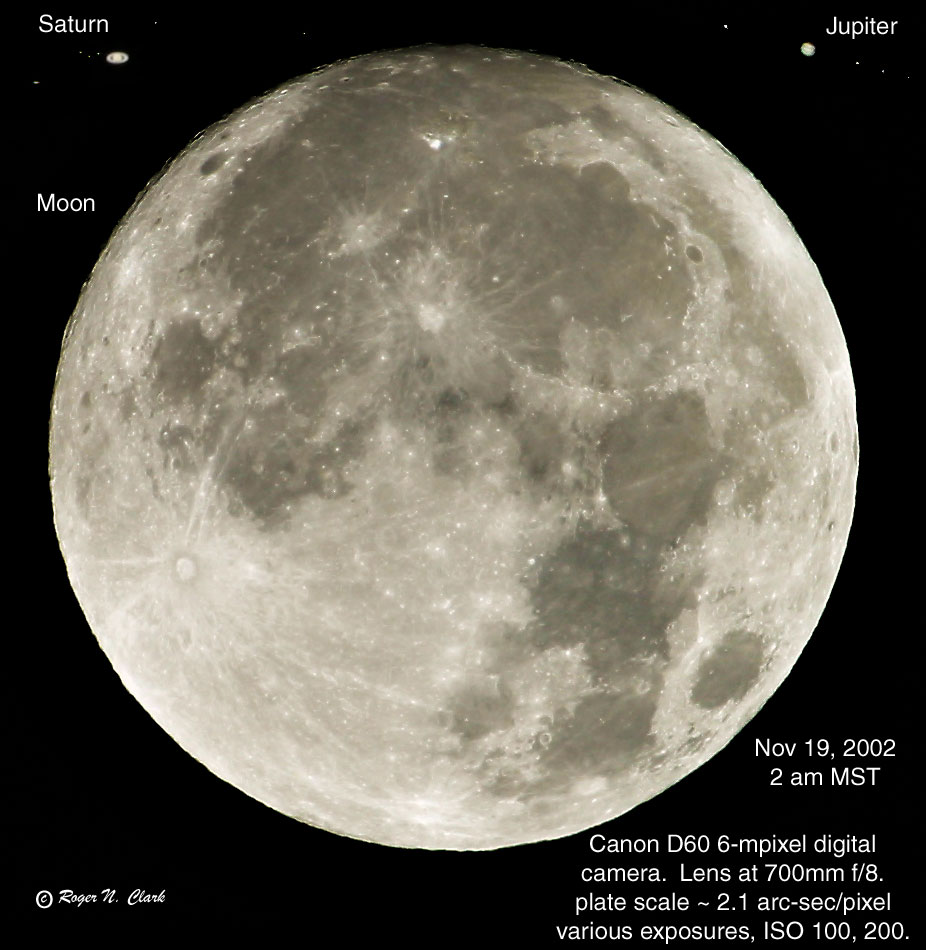| Home | Galleries | Articles | Reviews | Best Gear | New | About | Contact | Gallery Index | Previous |
Next |

| Home | Galleries | Articles | Reviews | Best Gear | New | About | Contact | Gallery Index | Previous |
Next |

The images here were all done within a few minutes of each other and combined to show the sizes they appear in the sky at that time, November 19, 2002, a little before the Leonid Meteor storm peak. The images were obtained with a Canon D60 6-megapixel digital camera and a 500 mm f/4 telephoto lens and a 1.4x teleconverter for a focal length of 700mm. The combination was set to f/8. The moon was 1/250 second at ISO 100 at 2:05 am MST, Saturn disk was 1/8 second at ISO 100 at 2:08 am MST. Saturn's satellites were 1 second at ISO 200 at 2:08 am. Jupiter disk was 1/90 second at ISO 200, 1:59 am. Jupiter's satellites were 1/2 second at ISO 200 at 2:00 am.
All images are presented at full resolution. The satellites have been strongly stretched so they appear. For example, some of Saturn's satellites had DN's of only about 5. Titan is the moon below and farthest to the left of Saturn and appears slightly elongated because of rotation of the earth. The other Saturn satellites do not show smear because of the strong stretch resulted in only the strongest pixel showing.
More technical Details
The moon is about 0.5 degree in diameter. The size in the film plane is: moon diameter ~ 700 mm * tan(0.5) = 6.1 mm
This size is true regardless of the sensor, e.g. Canon D60, 35mm film, 4x5 film, etc. The focal length of the lens is all that matters.
The Canon D60 has pixel spacing close to (exactly?) 7.5 microns, or 0.0075 mm. The moon's image at 6.1mm would then be 6.1 / .0075 = 813 pixels (I measured the moon image to be 809 pixels; look up the exact diameter of the moon at the time of the image and recalculate as the diameter varies a few percent).
Jupiter is 39 arc-seconds across. At 700 mm, Jupiter should appear 700 * tan(39/3600) = 0.132 mm diameter = .132/.0075 = 18 pixels. I measured the equatorial diameter at 17 pixels, but the limb is lost due to limb darkening and the stretch I applied to bring out the belts. Look up the diameter of Saturn and calculate its size--it will be as expected too.
Jupiter's moon's positions agree with the chart in Astronomy magazine for that day and time. Ganymede is on the left side of Jupiter and going away from Jupiter on the right is Io, Europa, and Callisto. The brightness of the dots agrees with the stellar magnitudes of the satellites, Ganymede being brightest and Callisto faintest of the 4.
Titan is the moon to the lower left of Saturn, at magnitude 8.4. To the left of Saturn, the three satellites from outermost going in: Rhea at magitude 9.8, Dione at 10.2, and Tethys at 10.3. Enceladus and Mimas are not seen, being closer in and fainter. Iapetus (magnutide 10.3) is the point to the upper right of Saturn (I still need to confirm this). The point further to the right of Saturn is probably a star.
Saturn's satellites show that the 500 mm f/4 lens and D60 at ISO 200 can record stars of magnitude 10.3 in 1 second.
Regarding resolution, the lens is a 500 mm f/4, 5-inch aperture, but at 700 mm (using a 1.4x teleconverter), the aperture at f/8 is 700 / 8 = 87.5 mm = 3.4 inches. The Airy disk diameter (first dark ring minimum) is given by (approx, green light):
A = 2 * 5.45/D
where D is the aperture in inches and A is the Airy disk diameter in arc-seconds. For a 3.4 inch diameter aperture, the Airy disk is then 2 * 5.45/3.4 = 3.2 arc-seconds. Since the D60 sensor plate scale is 2.1 arc-seconds per pixel, if the optics were perfect and diffraction limited, the resolution would be limited by the D60 sensor. The resolution in the image is about what one would expect, and mostly limited by diffraction and the D60.
Resolving the moons around Saturn has little to do with the Earth's moon's light. It was actually difficult because of the bright light from Saturn itself, especially for that closest moon. It was a weak signal, but right at what one could expect with the D60. (By the way for you astronomers, the tests of the D60 I've done show that with the 500 mm lens at f/4, it can reach about magnitude 15 in 30 seconds at ISO 800!).
To learn how to obtain stunning images like this, please visit my Extensive Articles on Photography .
Keywords to this image = astrophoto-1 moon planet saturn jupiter night low-light digital_astro
Image ID: moon_saturn_jupiter.d60.v1.jpg
| Home | Galleries | Articles | Reviews | Best Gear | Science | New | About | Contact |
Last updated November 03, 2025